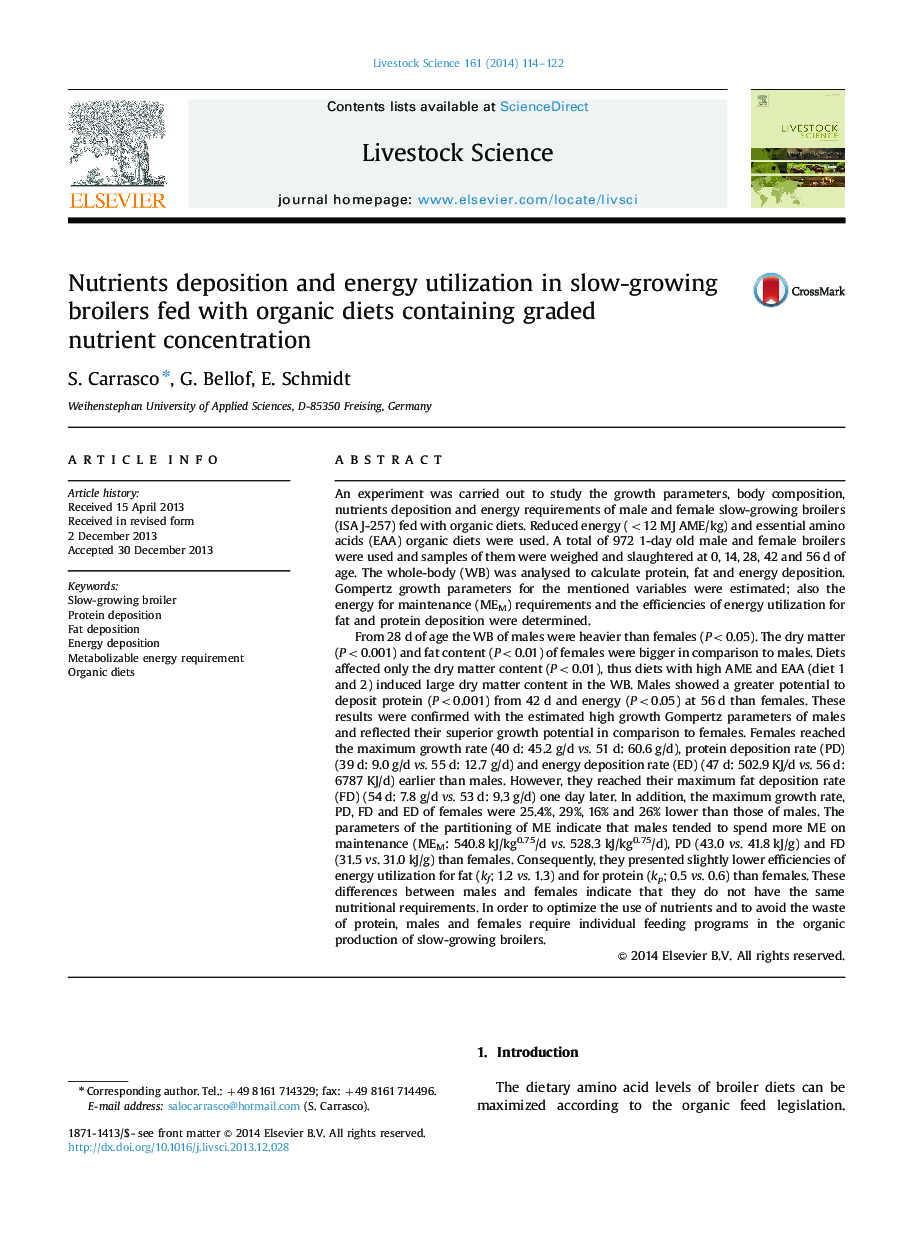| کد مقاله | کد نشریه | سال انتشار | مقاله انگلیسی | نسخه تمام متن |
|---|---|---|---|---|
| 2447244 | 1553971 | 2014 | 9 صفحه PDF | دانلود رایگان |
An experiment was carried out to study the growth parameters, body composition, nutrients deposition and energy requirements of male and female slow-growing broilers (ISA J-257) fed with organic diets. Reduced energy (<12 MJ AME/kg) and essential amino acids (EAA) organic diets were used. A total of 972 1-day old male and female broilers were used and samples of them were weighed and slaughtered at 0, 14, 28, 42 and 56 d of age. The whole-body (WB) was analysed to calculate protein, fat and energy deposition. Gompertz growth parameters for the mentioned variables were estimated; also the energy for maintenance (MEM) requirements and the efficiencies of energy utilization for fat and protein deposition were determined.From 28 d of age the WB of males were heavier than females (P<0.05). The dry matter (P<0.001) and fat content (P<0.01) of females were bigger in comparison to males. Diets affected only the dry matter content (P<0.01), thus diets with high AME and EAA (diet 1 and 2) induced large dry matter content in the WB. Males showed a greater potential to deposit protein (P<0.001) from 42 d and energy (P<0.05) at 56 d than females. These results were confirmed with the estimated high growth Gompertz parameters of males and reflected their superior growth potential in comparison to females. Females reached the maximum growth rate (40 d: 45.2 g/d vs. 51 d: 60.6 g/d), protein deposition rate (PD) (39 d: 9.0 g/d vs. 55 d: 12.7 g/d) and energy deposition rate (ED) (47 d: 502.9 KJ/d vs. 56 d: 6787 KJ/d) earlier than males. However, they reached their maximum fat deposition rate (FD) (54 d: 7.8 g/d vs. 53 d: 9.3 g/d) one day later. In addition, the maximum growth rate, PD, FD and ED of females were 25.4%, 29%, 16% and 26% lower than those of males. The parameters of the partitioning of ME indicate that males tended to spend more ME on maintenance (MEM: 540.8 kJ/kg0.75/d vs. 528.3 kJ/kg0.75/d), PD (43.0 vs. 41.8 kJ/g) and FD (31.5 vs. 31.0 kJ/g) than females. Consequently, they presented slightly lower efficiencies of energy utilization for fat (kf; 1.2 vs. 1.3) and for protein (kp; 0.5 vs. 0.6) than females. These differences between males and females indicate that they do not have the same nutritional requirements. In order to optimize the use of nutrients and to avoid the waste of protein, males and females require individual feeding programs in the organic production of slow-growing broilers.
Journal: Livestock Science - Volume 161, March 2014, Pages 114–122
